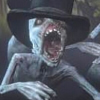ENTRY 20: THE CELESTIALS
These rare enemies have a classic space alien look, with big bulbous heads on their pot-bellied, spindly-limbed bodies. Their heads specifically look a lot like the rounded "head" (also body. Mollusks are weird) of an octopus, which also kind of evokes the cap of some sort of mushroom, speckled with pale blue spots that seem dimly luminous.
Beneath this "mushroom cap" is the minion's face, two intense little points of white light set in shallow eye sockets while the rest of the face is sort of scrunched up and pinched together, traces of a humanlike nose and mouth just barely visible anymore. I will admit they felt kind of cuter before I noticed those remaining human features, more insect-like, but I appreciate the pitiful uncanniness those details really bring out. The whole thing still looks incredibly sad, in kind of a pug dog way, like if this creature could speak it would probably speak like Droopy, or maybe like Hans Moleman.
Some minions can also extrude a mass of brightly luminous tentacles from the spots on their heads, and these allow the creature to release blasts of energy, though it's worth noting that minions don't generally attack until you hit them first. Like Rom, they either have no violent intent or they just have better things to pay attention to.
A boss version of this enemy is known as the Celestial Emissary, and it can be encountered first at a Lumenflower Garden, resembling a field of strange, giant sunflowers. The Emissary resembles the minions almost exactly, except for its much larger size, brighter glowing blue eyes and ability to summon meteors. While the Celestial Minions are considered mere kin, however, the Emissary is categorized as a true Great One. How?!
The minions and the Emissary seem to be a culmination of the insight experiments we've already seen, an example of what the Clocktower Patients were really meant to become. The Healing Church actually ran an "orphanage" that eventually turned children into these creatures, and disturbingly, you can have an unknowing hand in the creation of even more; there's an ostensibly safe haven you can send some NPC's, but later, you may find them missing, and a few of these creatures wandering the area.
The DLC research hall content even includes a middle ground between the malformed patients and the emissary, the Living Failures boss battle. These clumsier, less stable attempts at an emissary have asymmetrical, partially deflated looking heads! How did the experiments go from so many hideous prototypes to turning a human into a lesser Great One?
Following the battle with the first Celestial Emissary, you can find the item A Call Beyond in the gardens. This is a Phantasm resembling a cute little sea angel, lacking wings but displaying its oral tentacles, and allows you to use the same meteor attack. It seems like implantation of this particular parasite is what created the minions and emissaries, but its success also hinged on the use of the Lumenflowers; these are associated in the game with a "milkweed rune," and the implication of that is that the flowers provided some kind of nourishment vital to the proper development of these parasites.
Classic sci-fi "aliens" aren't a theme you really expect in these games, and even a lot of cosmic horror avoids the cliche of a big headed Martian looking invader. That's not what these are, of course, but they perfectly blend the tropes of that archetype with the kind of dark fantasy Bloodborne is going for.






























